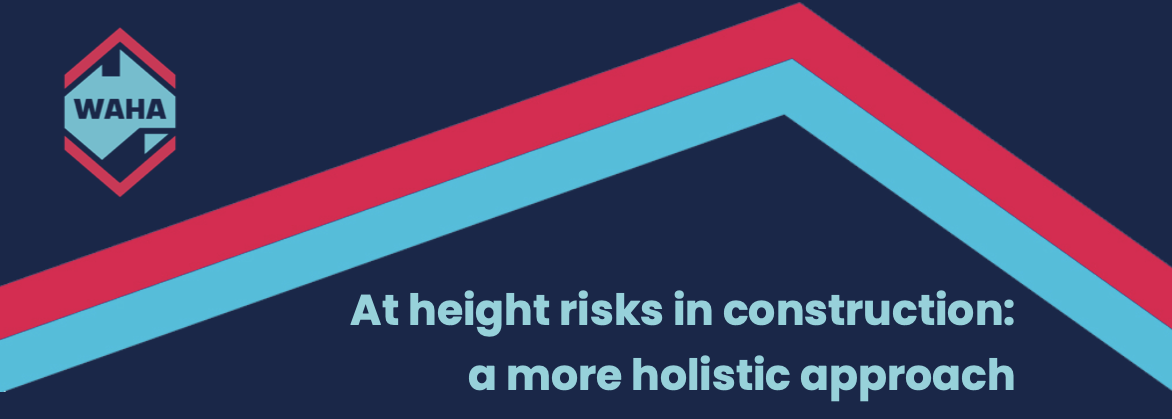
This Article was written by the WAHA CEO, Scott Barber, for Safety Solutions.
When it comes to deaths and serious injuries resulting from falls from height, construction workers top the list. Despite a focus from regulators, a more holistic approach is needed to improve worker engagement and manage risks through fall protection measures, training and environment-specific solutions.
According to Safe Work Australia data, the workers most at risk of death and serious injury as a result of falls from height are those in the construction industry. The most recent published statistics indicate that there have been 122 fatalities attributed to falls from heights over the past five years, accounting for 13% of all worker fatalities over that period. The figures also indicate that even though serious workers compensation claims resulting from falls from heights declined by 17% between 2009–10 and 2018–19, falls from heights still accounted for 6% of serious claims. If we reference the latest data, the 2019 statistics, they indicate that of the 183 fatalities over that 12-month period, 11% are credited to falls from height and another 11% attributed to falling objects. That’s a total of 42 deaths with an aligned mechanism of injury.
These findings paint a clear picture; despite the focus from regulators and the ever-present risk of working at height, it appears that there is still a lack of engagement with best practice around the management of the key risks despite the devastating effects on workers’ wellbeing and safety. What is also clear is that there is a decisive link between the nature of the environment where these incidents occur and the resultant statistic whereby 22% of the worker fatalities in the construction sector occur from what can be described as ‘at-height’ incidents.
The dangers
The outcomes of falls in the workplace are more likely to be life-threatening when compared to many other incident types. While other common mechanisms of injury, such as manual handling, overexertion, and vehicle or machine accidents are more likely to cause injury to a particular body part, the injuries resultant from falls can easily have wider-spread complications that can affect the whole body, cause significant damage to vital organs and, if not directly resulting in death, have life-altering, long-term consequences.
In other words, working at height may not be the most common incident type, but when incidents do occur, they are much more likely to be fatal compared with other occupational hazards. With such potential consequences, there is a need to address work at height as a broader risk profile. Increasing awareness around the potential for harm and the methods for avoiding these hazards will create more effective engagement and eventually lead to a reduction in events. Knowledge is power, so underestimating and devaluing the high-risk nature of the work environment, and consequently, the level of competency required to operate safely in these spaces, leads directly to a higher incident rate. Ensuring those working at height are educated sufficiently to assess risk appropriately and manage it accordingly is the key to the reduction in these statistics.
Using safety protection correctly
Effective fall protection depends on an informed choice of equipment, the knowledge of how to use it correctly and how to safeguard oneself and others from potential hazards. Workplace safety is, therefore, a two-step process that involves technical support from safety systems and personal protective equipment (PPE) that can shield and protect in dangerous situations and secondly, human support in the shape of comprehensive training, instructions in the form of safe work method statements and expert guidance and advice. Neglecting either of the two will potentially lead to deficiencies in safety systems, resulting in breaches of procedure and a more exposed worksite.
Only professional, competent health and safety specialists can advise on how to design effective solutions and increase compliance while accounting for site-based and case-specific conditions. Safety equipment has become vastly more effective and affordable in recent years, making it easier to choose the right solution for specific tasks. This is a shift from specifying a one-size-fits-all solution and the assumption it will provide protection regardless of task specifics. Utilising a combination of fall arrest systems, edge protection and safety equipment, including PPE and tool lanyards, will lead to a reduction in incidents if used correctly.
Applying the hierarchy of controls informs and frames the most suitable approach to solutions modelling, so engaging with a subject matter expert will help identify the most suitable path forward. But ultimately, correct use is the key; even the newest and most expensive equipment cannot be effective if the worker does not know how to use it properly. While there are many guides on equipment selection, these guides are based on a hypothetical application and assumptions around work environment and do not provide the unique risk-profile and informed criteria that can only be determined by truly competent subject matter experts, be they internal or external consultants. Combined with practical training, not just theory-based working at height courses, operators at height can apply the tools and techniques more efficiently, empowering individuals to make safer choices without needing to compromise due to poor equipment selection.
Therefore, safety training should be a top priority for any company, regardless of the size or the industry. Safety training, performed by professional subject matter experts at regular intervals, will educate crews on how to use the equipment, how to spot a potential hazard, and maintain skillsets and a safety culture in the workplace that will inspire more awareness and interest in working safer. Applying application specifics into training packages allows for the inclusion of the safe use of tools and tool lanyards in height-based work environments. Including these processes into a formal work method helps mitigate the risk of dropped objects highlighted in the statistics.
The future of fall protection
At a state and territory level, SafeWork and WorkSafe are running fall prevention campaigns as part of an initiative to decrease the number of victims of falls from height. This includes the highlighting of dropped objects as a significant contributor to injury and fatality statistics. In the end, however, even with the active campaigning from regulators, the responsibility for creating awareness among a workforce and instituting change when it comes to safety culture and processes lies with the employer. But by empowering those who work at height with the suitable knowledge and skill sets to appreciate the true nature of the risk, an effective multilateral approach can be applied.
The future of safe working at heights will be decided in close cooperation and collaboration with those directly affected by it, the employees. Ensuring appropriate training is provided as a key component of all at height tasks and not relying on ‘tick-the-box’ approaches to safety training ensures operators are prepared and able to continually assess hazards throughout the task, with situational awareness being supported by actual competencies. Companies that look at safety as a task that can be handled on the executive level are taking the wrong approach. An understanding of safety culture will only reach the worker if they are engaged, skilled and involved in the discussion, and only then can all work together to reduce fatalities.






